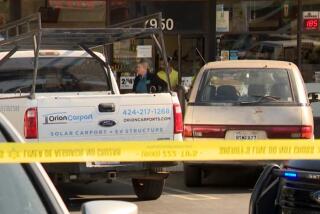Life of Pain for Drivers Who Kill Pedestrians
Friday is the first anniversary of the tragic accident at the Santa Monica Farmers’ Market that killed 10 people and injured 63. The number of victims makes this accident especially horrifying, and especially harrowing for the man who was behind the wheel, George Russell Weller.
On that day, Weller joined a large, unhappy club. Other members include First Lady Laura Bush, actor Matthew Broderick, former South Dakota Rep. William J. Janklow, former Bishop Thomas O’Brien of Arizona and me. We have all killed people in traffic accidents.
Each year, more than 120,000 U.S. drivers kill or seriously injure pedestrians or bicyclists. Contrary to popular belief, fewer than 15% of these drivers are drunk. In fact, the adult pedestrians involved in these accidents are more than twice as likely to be intoxicated as the drivers who hit them.
In June 1977, I killed an 8-year-old boy named Brian when he darted into the street in front of my car in rural Ohio. I was 22 years old. For months, I was overwhelmed by grief, guilt and sheer terror. Memories of the accident hijacked my attention, disrupted my work, strained my relationships and sapped my energy. I continued to drive for a few months after the accident, but I would imagine people in the roadway and have to pull over. Finally, I sold my car and gave up driving for two years.
Over time, many of these difficulties faded. But, even today, the accident haunts me, and I am still an overly cautious driver. I decided against becoming a parent because I did not trust myself to keep a child safe. Shortly after the accident, I visited Brian’s father and wrote to family members, who were all very kind. We’ve had no contact since, but every day for almost 30 years I have thought about Brian and his family.
Like me, many drivers who accidentally kill or injure others will spend a lifetime trying to atone for what happened. Post-traumatic stress disorder is the term for many of the difficulties I experienced, but this does not fully capture my struggle to understand the nature of responsibility and to find a measure of redemption or meaning.
As a society we turn away from these drivers’ needs and pain. There are no self-help books or support groups for us. Police, hospital personnel and social service workers receive no training about how to respond to our distress, even though their reactions have long-term effects.
Guilt and shame effectively silence and isolate many of us. Lawyers advise us not to talk about our accidents, and especially not to apologize, because that could be seen as an admission of liability. Well-meaning friends and family tell us to not to dwell on what we cannot fix.
We are vivid reminders of human fallibility and the capriciousness of fate. Some of us were negligent, of course, while others were simply unlucky. Even the most careless, however, did not intend to cause harm. Recognizing the humanity of these drivers means recognizing that good people can make terrible mistakes. And that every one who gets behind the wheel of a car runs the risk of accidentally hurting or killing someone else. To acknowledge this makes the world a more frightening place.
Weller has pleaded not guilty to 10 counts of vehicular manslaughter with gross negligence. Although we’ve never met, my own experience tells me that even the harshest punishment the judicial system metes out cannot match his private anguish. When we turn away from the needs, pain and distress of those who unintentionally kill, we only compound the toll that accidents take.
More to Read
Sign up for Essential California
The most important California stories and recommendations in your inbox every morning.
You may occasionally receive promotional content from the Los Angeles Times.









